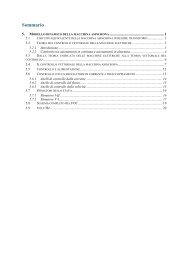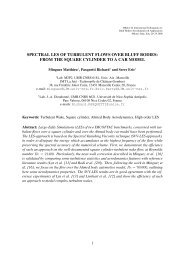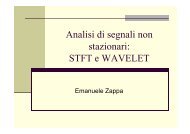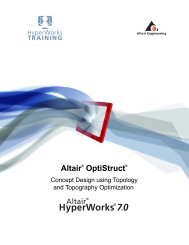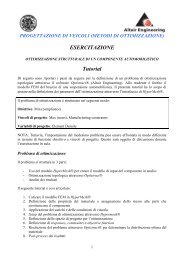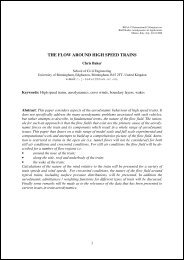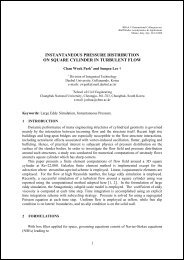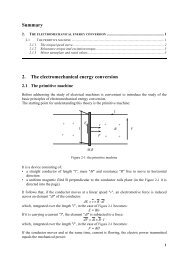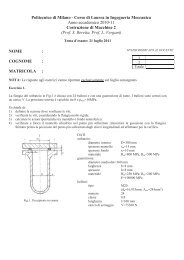Dispense del corso (aggiornate al 10 giugno 2012) - Costruzione di ...
Dispense del corso (aggiornate al 10 giugno 2012) - Costruzione di ...
Dispense del corso (aggiornate al 10 giugno 2012) - Costruzione di ...
Create successful ePaper yourself
Turn your PDF publications into a flip-book with our unique Google optimized e-Paper software.
con derivazioni successive è possibile scrivere le relazioni:∂ 2 ɛ x∂y 2 = ∂3 u∂y 2 ∂x∂ 2 ɛ y∂x 2 = ∂3 v∂x 2 ∂y∂ 2 γ xy∂x∂y =∂3 u∂y 2 ∂x +∂3 v∂x 2 ∂yda cui otteniamo l’equazione <strong>di</strong> congruenza (nei testi inglesi viene detta compatibilità):∂ 2 ɛ x∂y 2 + ∂2 ɛ y∂x 2 = ∂2 γ xy(2.20)∂x∂yT<strong>al</strong>e equazione <strong>di</strong>fferenzi<strong>al</strong>e deve essere sod<strong>di</strong>sfatta d<strong>al</strong>le componenti <strong>di</strong> deformazioneper assicurare che esistano funzioni u e v continue che possano esprimerele deformazioni attraverso la Eq. 3.3.2.3.2 Problemi tri<strong>di</strong>mension<strong>al</strong>iNei problemi tri<strong>di</strong>mension<strong>al</strong>i si possono scrivere <strong>al</strong>tre due equazioni simili <strong>al</strong>laEq. 2.20 permutando gli in<strong>di</strong>ci x − y − z e si ottiene:⎧⎪⎨⎪⎩∂ 2 ɛ x∂y 2∂ 2 ɛ y∂z 2∂ 2 ɛ x∂z 2+ ∂2 ɛ y∂x 2+∂2 ɛ z∂y 2+∂2 ɛ z∂x 2= ∂2 γ xy∂x∂y=∂2 γ yz∂y∂z=∂2 γ xz∂x∂zAltre tre equazioni possono essere ottenute con ugu<strong>al</strong>e proce<strong>di</strong>mento:⎧∂ 2 ɛ x∂y∂z = ∂ (− ∂ɛ yz∂x ∂x + ∂ɛ xz∂y+ ∂ɛ )xy∂z⎪⎨∂ 2 ɛ y∂x∂z = ∂ (− ∂ɛ xz∂y ∂y+ ∂ɛ xy∂z+ ∂ɛ )yz∂x∂ ⎪⎩2 ɛ z∂x∂y = ∂ (− ∂ɛ xy∂z ∂z+ ∂ɛ yz∂x + ∂ɛ )xz∂y(2.21)(2.22)Si può <strong>di</strong>mostrare che le 6 equazioni <strong>di</strong>fferenzi<strong>al</strong>i <strong>del</strong> secondo or<strong>di</strong>ne 2.21 e 2.22sono equiv<strong>al</strong>enti a tre equazioni <strong>di</strong>fferenzi<strong>al</strong>i <strong>del</strong> quarto or<strong>di</strong>ne [3].2.3.3 Compatibilità per il FEM*Avendo introdotto la compatibilità attraverso la semplice spiegazione <strong>di</strong> Fig.2.5, v<strong>al</strong>e la pena approfon<strong>di</strong>re come la compatibilità sia verificata in una an<strong>al</strong>isiad Elementi Finiti.Quando un solido viene <strong>di</strong>scretizzato in elementi finiti, ad essi viene associatoun campo <strong>di</strong> spostamenti (u(x, y) e v(x, y) per problemi 2D, u(x, y, z), v(x, y, z)e w(x, y, z) per problemi 3D) che permetta <strong>di</strong> interpolare gli spostamenti nod<strong>al</strong>i,29



